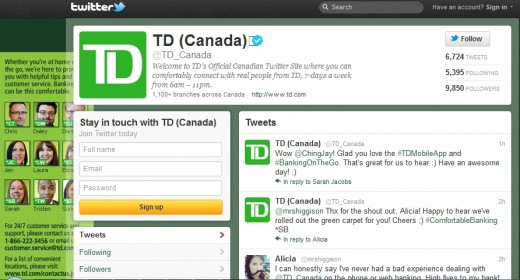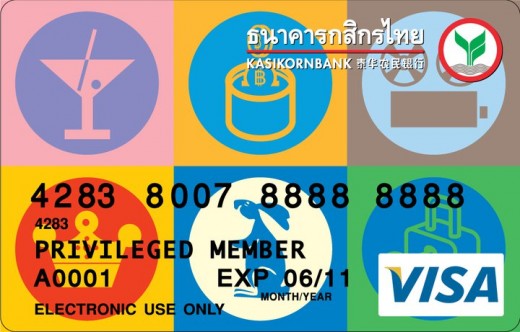
The emergence of social media has changed modern day communication. While that may sound like a cliché, it is a true fact and one that has disrupted the way that companies across a range of industries communicate with their customers and target audiences.
While the establishment of sites like Facebook, which boasts close to 850 million users worldwide, as mainstream channels of communication has come more easily to some industries than others.
Banking is one of the oldest and most prestigious industries yet social is not yet a mainstream channel, in the same way that is in sports companies, the retail industry and other consumer-facing spaces have embraced social networks and the Internet.
As adoption of social media is far from mainstream for banks, this article aims to focus at why that is the case, which brands are blazing a trail and how the rise of social media and the Web may influence the future of bank-consumer communications.
Why banks?
Banking is a notable industry because banks are a prerequisite for every adult in the world, although emerging markets do have a significantly lower ratio of usage.
The fact that most people need a bank account means half of the battle for consumers is won already as the demand is there. What is key for banks is an understanding of their customers and exactly what they are looking for; and that’s an area where social media can be hugely beneficial.
A tool for understanding customers
If there’s one key reason for banks jumping into social media it would the potential to understand customers.
Banks spend fortunes trying to get feedback and responses as they look gauge customer interest, yet all of that and more can be found online.
Social media is packed full of opinions, wishes and other comments. While it is true that a lot of that noise is irrelevant, if the data can be distilled, it has the potential to give banks vital insight and understanding of their existing and prospective customers and their wants and needs.
Challenge 1: Customers
The first challenge that presents itself is the caution of customers. While hundreds of millions of people have become comfortable with sharing their lives online — in a way that was almost unimaginable a few years ago — there are areas where they feel less safe online.
Money and bank details are arguably among the more troubling areas, and for good reason. Stories of websites and databases being hacked and bank details being stolen, email scams, viruses from the Internet and other incidents have trained many web users to be wary of using money online. To the point that this reluctance has manifested itself in communicating with banks and discussing anything financial online.
 According to a recent report from Avaya and BT, 69 percent of customers in the UK would not use social media to interact with their bank. While that figure is lower in the US (62 percent), Germany (64 percent) and Spain (47 percent), it doesn’t represent an audience that is particularly open to being communicated to. But a key problem is that many banks just aren’t doing it right.
According to a recent report from Avaya and BT, 69 percent of customers in the UK would not use social media to interact with their bank. While that figure is lower in the US (62 percent), Germany (64 percent) and Spain (47 percent), it doesn’t represent an audience that is particularly open to being communicated to. But a key problem is that many banks just aren’t doing it right.
A survey into 50 banks by Assetinum.com concluded that, though banks are beginning to step up social media accounts, few are actively using them and that is dissuading their audiences.
Though 42 of the banks used Twitter, just 26 were actively tweeting and engaging with customers. Two thirds of banks were found to be actively using Facebook, while just 15 banks made relevant use of YouTube.
On average the banks only scored one third of the possible total of assessment points for Twitter usage. Facebook scored worse than Twitter however, as just 18 banks (55 percent) with an active Facebook profile reacted to a test friend request, which the firm sees as a clear sign of “insufficient interaction with the users”.
Reflecting the mixed efforts, Benjamin Manz, managing partner of Assetinum, called the strategies implemented by the banks “amateurish”.
“For a surprisingly high amount of banks a convincing social media strategy is still not distinguishable,” he says in the report, which analysed the social media performance of leading private banks worldwide.
Though the confidence figures are low, banks must take a part of the blame here. The level of activity from banks on social media is one big factor that can put customers at ease and give them greater confidence, although it won’t convince them all, of course.
Challenge 2: Selling social media internally
Part of the problem is that banks do not understand how to strategically use social media, or have problems ‘selling’ the idea and benefits to senior executives.
“There is no return on investment for social media,” says Singapore-based bank marketing specialist Rob Findlay, “but many senior executive just don’t get that. You can’t really measure it, it’s like trying to find the ROI of your mother.”
Findlay, who has worked at Australia Nation Bank (NAB), one institution well know for embracing social media, explains that banks are beginning to embrace social media.
“Initially, many were fairly reluctant but now they are getting involved,” he says. “It’s a little bit like watching a kid sit on the edge of the pool waiting to get it.”
Let’s take a look at which brands have made a splash and how they can expect to benefit from getting wet.
Examples and incentives for social media platforms
Subtly appears to be the key for banks who have grown their presence on Facebook. Perhaps that’s no surprise, given the privacy concerns that most users on the social network have but is interesting to note that banks with the most fans have leverage ‘extra curricular activities.
JP Morgan Chase’s Community Giving page is dedicated to channels donations that the bank gives to charities.The initiative began in 2009 and a new extension announced last year saw Chase commit an additional $25 million to the philanthropic Facebook program.
British banks Barclays and RBS have made use of their commitment to sports — football and rugby respectively — to grow their Facebook footprint and show that just sticking to banking isn’t going to bring in big numbers.
That emphasis is backed up by Standard Chartered Bank which has seen its sponsorship of global icon Liverpool Football Club bring it to the attention of many people worldwide.
“Our most popular topics for content, based on listening as well as engagement are, our sponsorships of Liverpool FC and nine marathons across the globe, as well as our sustainability activities,” Standard Chartered’s Marged Lloyd, Group Head of Online Communications, explained to The Next Web.
Twitter is perhaps the most obvious tool for banks as it allows for a more direct customer service experience. Canadian bank TD (@TD_Canada) is a prime example.
TD uses the service to provide as part of its customer services push to respond to customer tweets and provide information to its followers. Staffed by 9 social media staff, TD has built up almost 10,000 followers by providing a more personal approach, allowing customer to “comfortably connect with real people at TD”.
While a large number of banks have claimed their Twitter handle, far fewer have followed TD’s lead by investing in the channel. If you’re a prospective bank account owner in Canada, the idea that you could avoid a lengthy telephone wait and tweet a basic question is quite an attractive one.
That said, Twitter does have its limits as there are still many questions that are too private or specialised for it, however it is offering a complimentary service in addition to others
Foursquare
While location-based service Foursquare may not seem like having obvious synergy for banks, one in Thailand has used it to appeal to customers that enjoy the service.
Kasikorn Bank has been a heavy user of Twitter and Facebook for some time and, in 2010, it made the unique move to embrace Foursquare.as part of its social footprint.
The bank gave its users prizes in exchange for becoming the major of its selected branches, and also picking up majorships at selected retail outlets across Thai capital Bankok. Special Foursquare debit cards were also made available to users.
The bank’s use of Foursquare has subsequently passed [in Thai] but it says that it is planning to introduce more schemes in the future.
Google+
As the newest mainstream social network on the Internet, Google+ is unsurprisingly further behind when it comes to brand interaction, as well as users.
While the debate about just how popular Google+ is will continue to go on, there is no doubt that the service offers a unique set of possibilities through which banks could communicate with customers.
In addition to a layout that places emphasis on images — to the point that Facebook introduced a new layout for photos that is remarkably similar — Hangout is a feature quite unlike anything on any other social network.
Plenty of celebrities have used Hangouts to connect with fans — US President Obama, NASCAR, Middle Eastern pop stars, Japanese girlbands and others — but it remains a largely untapped tool for retailers, brands and banks.
While there are limitations on the number of attendees and it is not private enough to discuss personal finance details, Hangouts could be an interesting way to hold a first meeting or general FAQ session for prospective bank clients.
Certainly the alternative of a Hangout rather than a face-to-face meeting or conversation is a real differentiator, especially when considering that most correspondence from banks is comparatively slow and formal.
There are some banks using Google+, as Visible Banking notes, with NAB leading the pack, although it has adopted a Twitter-like approach with no Hangouts so far.
YouTube
Building on the visual possibilities of Google+ Hangouts, YouTube is arguably the most ideal place to use multimedia content. Consistently ranked as one of the top websites anywhere in the world, The Google-owned video site sees more than 800 million visitors per month, according to Ad Planner, which would account for a vast number of current and prospective customers.
Not only that but YouTube videos can be embedded and share in blogs, websites and social networks across the Internet increasing the reach.
Unlike other social networks, YouTube is much more of a one way conversation, which restrictions the value that banks from gather from it. However, with banking seen in a boring light by many, YouTube videos and clips could help provide a fresh and vibrant approach to stand out from the crowd.
Blogs
Blogs are often forgotten when analysing social media but they still carry significant sway and importance for brands. The attention on blogs comes from two angles: both communicating and listening.
A blog can help give a voice to an organisation and promote information and it is also a great way to personalize a brand and build and extend relationships with audiences and key influencers.
Bloggers are passionate and (very often) knowledgeable sources who can provide feedback, help and influence, while their writing can also help pinpoint issues, problems and give an indication of customer opinion.
There there are the occasional PR disasters, like the one that blew up in Singapore when a high-profile blogger was inspired by an advert promoting cake on birthdays, that are easier to deal with when a team has existing relationships and knowledge of local blogospheres and key influencers.
Adopting an integrated approach
Social networks themselves are simply the points of interaction and, more importantly than them, is the need for a cohesive and coordinated marketing that dovetails into existing communications efforts elsewhere.
A real challenge for banks, and other organisations is thinking digitally and ensuring that digital media is a part of PR and marketing, rather than a separate silo altogether.
“Social media requires a cohesive approach,” Findlay explains, “it needs to be integrated into other channels and properly resourced in order to relevant and stand a chance of success.”
SC is one bank that is doing that, and a recent awareness campaign in Singapore saw it make use of digital media to find and hire the World Coolest Intern’ campaign during 2010.
In addition to hiring a dedicated social media specialist from thousands of entries, the bank helped build a reputation as one that understands the media with existing customer and future ones.
SC’s Lloyd explained that the bank’s focus on social media began in 2009 and 2010 when it “identified that people were talking about us online.” Lloyd explains that the bank decided it needed to be involved in these discussions, “we have made a conscious decision to participate in these conversations in a meaningful way”, she explains.
While the decision to get involved, deciding how to react to the swirling mass of users and loss of control is not, so how did SC begin?
“Our social media strategy focuses on driving brand awareness and managing our reputation,” Lloyd says,”through select global and country-specific social channels.” Indeed, as well as household names like Twitter and Facebook, SC is involved on other local platforms including Weibo microblogging services in China.
Nothing to fear but fear itself
There is nothing to be afraid of, except fear itself, and Lloyd explains that SC keeps things simple and very much like traditional PR.
“We’ve opted for simple, low risk opportunities” she says, before explaining that the social media efforts dissect a wide range of existing efforts, including media relations, branding and sponsorships, crisis management, light-touch product promotion and reactive customer service.
Even beyond that there are opportunities within internal communications, recruitment, thought leadership and corporate social responsibility and charitable efforts, Findlay outlines. However he points out that, while SC may be one of the more savvy banks, many of its competitors are reluctant to open the door.
“Social media has been very foreign to banks,” the Australian explains. “It doesnt fall inside regular marketing, which is always one way traffic, pushing generic messages and communication.”
“Then there’s the fact that it can’t be controlled, suddenly customer has some power, one-in-many. Banks worry about the ramifications of being involved and the problems of not involved, but things get worse the longer that they wait.”
This loss of control is a worry for many industries but banks, with a lot of stake and boundaries which define where and how customers can be advised, are particularly cautious. However there are events and groups that are helping to show the promise of social media to banks.
Next Bank Asia
Aside from his day job at local Singaporean bank, Findlay is doing his bit to help banks in the region through a conference called Next Bank Asia. The inaugural event takes places 8-9 May in Singapore, and the concept is aimed at helping banks to improve their understanding and experience of social media, and other disruptive elements.
Findlay explains that Next Bank Asia is different to other social media workshops and events as it will approach issues from a disruptive angle and is organized entirely by those in the banking industry, like Findlay.
Future events will take place in other cities and regions in Asia to help encourage local support and attendance and accommodate the fast-changing social media space too.
Conclusion
While Facebook messages and Twitter DMs will never replace bank statements, banking is undeniably dragging behind on the social media revolution.
There are some banks taking steps forward but, as an industry, caution and lack of understanding is holding it back. While smaller more flexible organisations have picked up the slack early on, it seems like only a matter of time until bigger banks take notice and begin wooing customers through social networks.
There are some things that social media can never replicate, however, so don’t expect to lose those regular meetings with your bank manager…but you can still be friends on Facebook.
Get the TNW newsletter
Get the most important tech news in your inbox each week.








